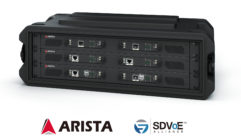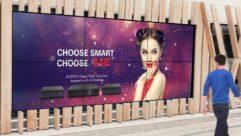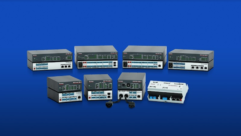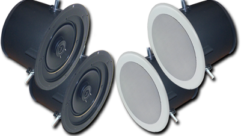Projectors 2020: In this first quarter, manufacturers have taken some interesting and wide-ranging approaches to the projector platform, adding analytics, software, and connectivity options, as well as features to simplify installation. Some have innovated to reduce size or increase refresh rate (for gaming).
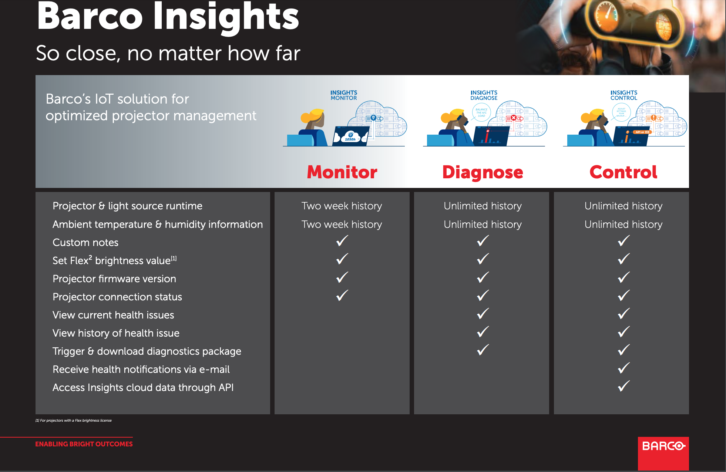 1. At ISE 2020, Barco debuted their next-gen business strategy with a new cloud-based Internet of Things solution for enhanced projector management. Barco Insights, as the connectivity platform is called, will simplify and facilitate remote monitoring and serviceability. It supports cloud-based storage of projectors’ usage data and light-source run-times. The live dashboards also give real-time information on the operating and environmental conditions of the projectors for more effective device analysis and proactive troubleshooting. Users can securely access the IoT platform on any device with an internet connection. There’s no complex setup and network configuration, no local host PC and no software to install. Rollout of this subscription-based cloud platform will happen in different stages with functionality becoming gradually available throughout 2020. The basic features will be automatically embedded in the UDM projectors for the first two years of usage.
1. At ISE 2020, Barco debuted their next-gen business strategy with a new cloud-based Internet of Things solution for enhanced projector management. Barco Insights, as the connectivity platform is called, will simplify and facilitate remote monitoring and serviceability. It supports cloud-based storage of projectors’ usage data and light-source run-times. The live dashboards also give real-time information on the operating and environmental conditions of the projectors for more effective device analysis and proactive troubleshooting. Users can securely access the IoT platform on any device with an internet connection. There’s no complex setup and network configuration, no local host PC and no software to install. Rollout of this subscription-based cloud platform will happen in different stages with functionality becoming gradually available throughout 2020. The basic features will be automatically embedded in the UDM projectors for the first two years of usage. 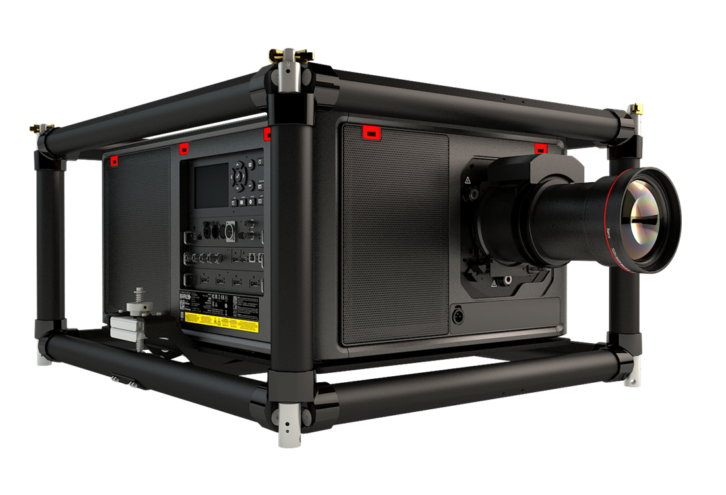 This included two new 15K lumens members of the 3-chip laser UDM range, the UDM-4K15 (UHD) and UDM-W15 (WUXGA), which join the large-format UDM-4K22 that began shipping this year, pitched at theme parks, museums, houses of worship and large auditoriums (there is also a WUXGA UDM 22K). The full UDM line can be rigged for permanent installation or rental/staging, and Barco’s Flex2 feature allows brightness level or resolution tuning for a specific show.
This included two new 15K lumens members of the 3-chip laser UDM range, the UDM-4K15 (UHD) and UDM-W15 (WUXGA), which join the large-format UDM-4K22 that began shipping this year, pitched at theme parks, museums, houses of worship and large auditoriums (there is also a WUXGA UDM 22K). The full UDM line can be rigged for permanent installation or rental/staging, and Barco’s Flex2 feature allows brightness level or resolution tuning for a specific show.
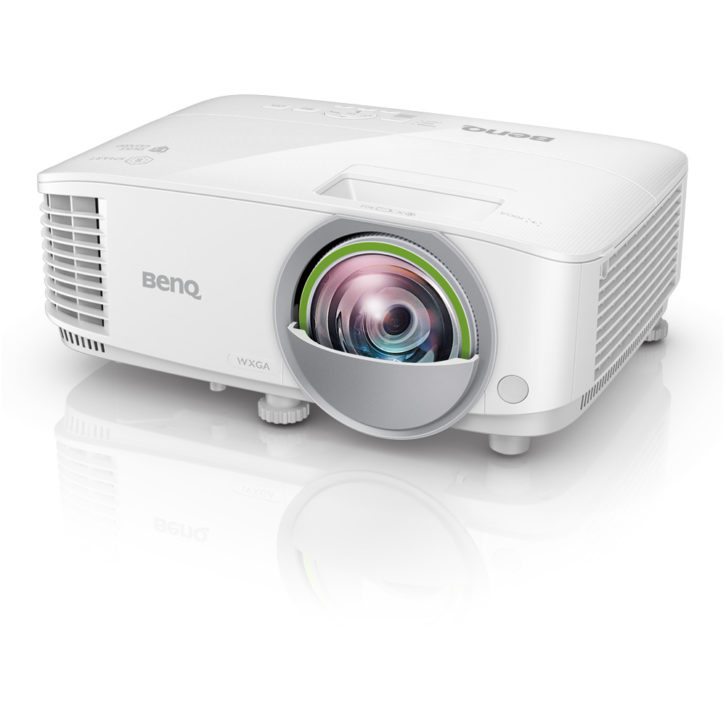 2. In February, BenQ introduced what it calls “the world’s first smart projector for business.” The EW800ST DLP short-throw (0.49) has cross-platform wireless screen-mirroring, built-in business apps, and Internet connectivity to support digital collaboration workspaces wirelessly via BYOD, whether smartphone, tablet or laptop and whether PC, Mac/iOS, Android— no software or cables required. With an eye towards a role in signage as well, the EW800ST also supports 360-degree rotation for projection onto ceilings, walls, floors or angled signage. The EW800ST also comes with a USB Type-A port that supports a wide range of file formats — including JPEG, PDF, Microsoft Word, Excel, and PowerPoint files. The projector comes with 16 GB of storage and builtin business apps that increase productivity during meetings. With one click to connect, participants can start a video conference with Blizz — a global team collaboration app — remotely access another computer to view files or troubleshoot via TeamViewer, create documents collaboratively via WPS Office, as well as search the internet on Firefox. Through BenQ’s X-Sign broadcasting technology, any connected device can send text, images, and video links to the EW800ST, and everyone in the meeting room will see the message immediately on the projection screen. BenQ Smart Control turns a smartphone into a remote control, a mouse pad, and a keyboard, allowing users to navigate the projector and its business apps directly from their own device. For text/ graphics-based presentations, Infographic Mode — a BenQ exclusive — showcases texts and graphics in detail with high brightness and better color gradation. Built-in dust and lamp-life technology reduces the projectors’ maintenance footprint. It is compatible with BenQ’s Device Management Solution (DMS) and Account Management System (AMS) tools. DMS enables remote and centralized management of multiple digital projectors via a local network, making it simple for IT managers to remotely monitor, control, configure, and update projectors individually or as groups at once.
2. In February, BenQ introduced what it calls “the world’s first smart projector for business.” The EW800ST DLP short-throw (0.49) has cross-platform wireless screen-mirroring, built-in business apps, and Internet connectivity to support digital collaboration workspaces wirelessly via BYOD, whether smartphone, tablet or laptop and whether PC, Mac/iOS, Android— no software or cables required. With an eye towards a role in signage as well, the EW800ST also supports 360-degree rotation for projection onto ceilings, walls, floors or angled signage. The EW800ST also comes with a USB Type-A port that supports a wide range of file formats — including JPEG, PDF, Microsoft Word, Excel, and PowerPoint files. The projector comes with 16 GB of storage and builtin business apps that increase productivity during meetings. With one click to connect, participants can start a video conference with Blizz — a global team collaboration app — remotely access another computer to view files or troubleshoot via TeamViewer, create documents collaboratively via WPS Office, as well as search the internet on Firefox. Through BenQ’s X-Sign broadcasting technology, any connected device can send text, images, and video links to the EW800ST, and everyone in the meeting room will see the message immediately on the projection screen. BenQ Smart Control turns a smartphone into a remote control, a mouse pad, and a keyboard, allowing users to navigate the projector and its business apps directly from their own device. For text/ graphics-based presentations, Infographic Mode — a BenQ exclusive — showcases texts and graphics in detail with high brightness and better color gradation. Built-in dust and lamp-life technology reduces the projectors’ maintenance footprint. It is compatible with BenQ’s Device Management Solution (DMS) and Account Management System (AMS) tools. DMS enables remote and centralized management of multiple digital projectors via a local network, making it simple for IT managers to remotely monitor, control, configure, and update projectors individually or as groups at once.
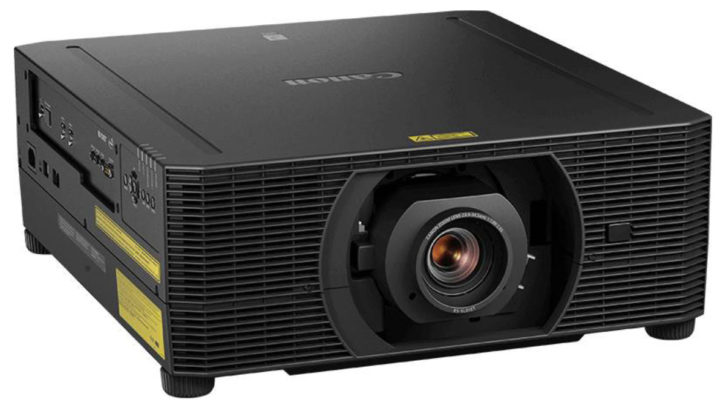 3. Canon has continued to target the need for compact, lightweight 4K projectors in 2020. The XEED 4K6021Z that debuted last year is a high brightness, native 4K laser projector, with dual Display Port connectivity. A LCOS laser delivers 6,000 lumens of brightness at 4K 10-bit 4:4:4, while still weighing in at 19kg. Despite the high brightness, Canon says its projector has been packed into a lightweight body, meaning it’s suitable for flexible installations. Using Canon’s LCOS reflective panel technology, this device claims a very high aperture ratio with virtually no gaps between pixels to create fine, detailed images free from the ‘lattice effect’, particularly useful for museums, design and creative installations. A simple spigot lens fitting is compatible with seven interchangeable lenses, including the RS-SL07RST 4K standard zoom lens which offers 1.76x motorized zoom and +/- 73% vertical lens shift. This lens can project images up to 600 inches and can even project onto curved surfaces; maintaining focus in the center of the image when peripheral focus has been adjusted. The XEED 4K6021Z can be installed in any 360-degree orientation, which, combined with its compact size, is ideal for challenging or creative environments.
3. Canon has continued to target the need for compact, lightweight 4K projectors in 2020. The XEED 4K6021Z that debuted last year is a high brightness, native 4K laser projector, with dual Display Port connectivity. A LCOS laser delivers 6,000 lumens of brightness at 4K 10-bit 4:4:4, while still weighing in at 19kg. Despite the high brightness, Canon says its projector has been packed into a lightweight body, meaning it’s suitable for flexible installations. Using Canon’s LCOS reflective panel technology, this device claims a very high aperture ratio with virtually no gaps between pixels to create fine, detailed images free from the ‘lattice effect’, particularly useful for museums, design and creative installations. A simple spigot lens fitting is compatible with seven interchangeable lenses, including the RS-SL07RST 4K standard zoom lens which offers 1.76x motorized zoom and +/- 73% vertical lens shift. This lens can project images up to 600 inches and can even project onto curved surfaces; maintaining focus in the center of the image when peripheral focus has been adjusted. The XEED 4K6021Z can be installed in any 360-degree orientation, which, combined with its compact size, is ideal for challenging or creative environments.
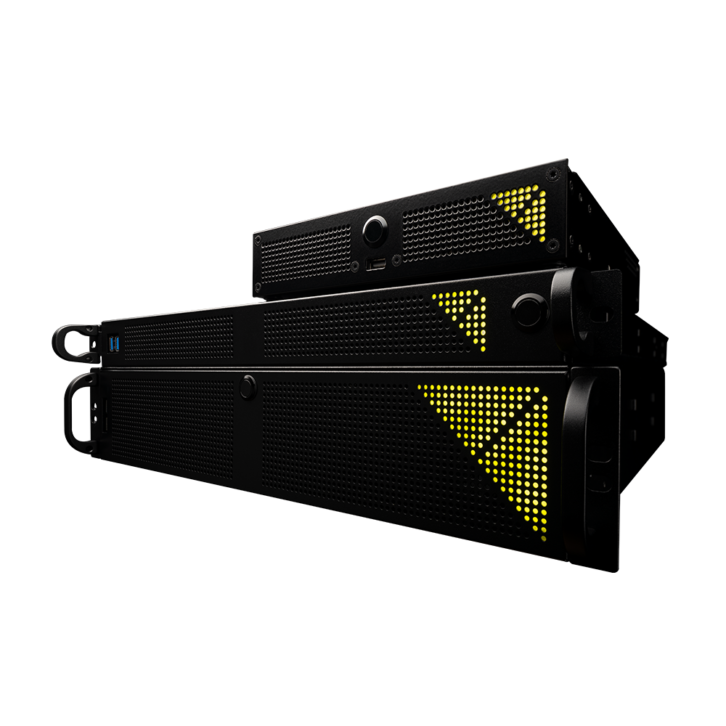
At ISE 2020, Canon also collaborated with AV Stumpfl to exhibit an 8K projection solution. On the booth, the AV Stumpfl PIXIERA Two server delivered and managed the 8K content – captured using Canon kit and served to Canon projectors.
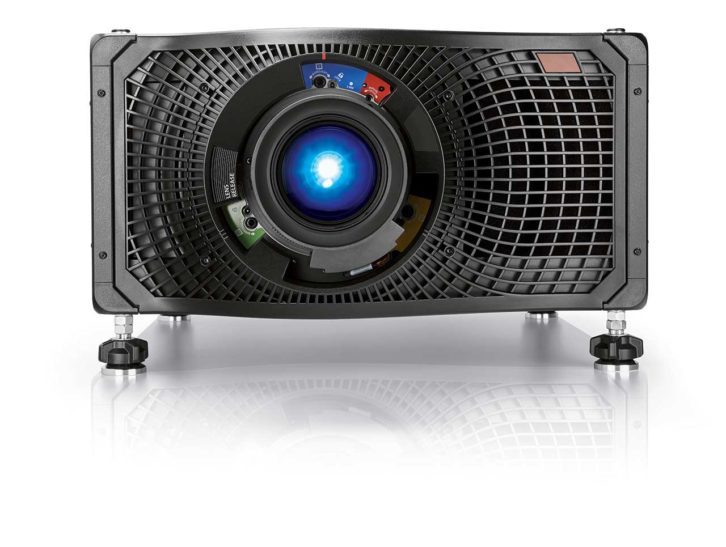
4. The Christie booth ISE 2020 saw the 2020 show debut of both the Christie Roadie 4K40-RGB and the Mirage SST projector, which were announced at InfoComm last year. With its omnidirectional, quiet, and ultra-compact, fibre-coupled projection head, the Mirage SST 4K 35,000 lumen RGB laser projection system has been designed for tight, challenging environments, such as domes or themed attractions. The Christie Roadie 4K40-RGB pure laser projector is purpose-built for life on the road and other demanding applications; the Roadie’s “love handles” double as rigging points. In addition, Christie also made a point to demonstrate how their projector ecosystem is about more than projectors. The centerpiece of their booth was a 360-degree 3D projection mapping display with augmented reality (content by Loop Light GmbH). The four Christie D20WU-HS Series projectors were driven by the Christie Spyder X80, the Christie Mystique for automated 3D camera-based alignment, Christie Pandoras Box in 64-bit, and Terra SDVoE AV-over-IP solutions. 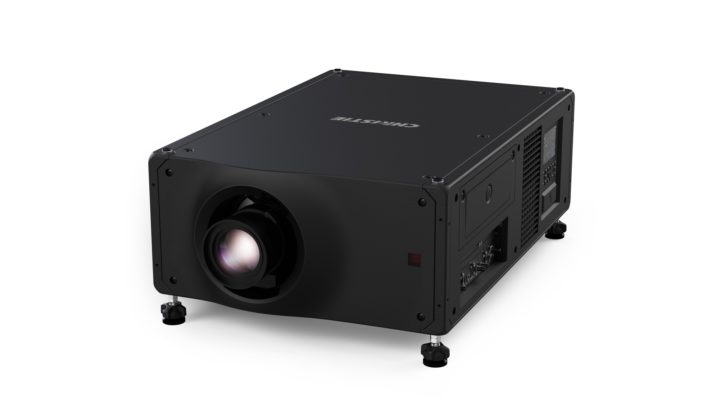 Christie also announced two new 3DLP Crimson laser projector models with increased brightness (priced the same as its Crimson 25 predecessor). Both Crimson Series WU31 and HD31 models deliver 31,500 ISO lumens, Christie BoldColor Technology, Christie TruLife Electronics and the built-in warping and blending capabilities of Christie Twist. With a Crimson 31 as the source projector, visitors can also experience Guardian – an optional Mystique feature – as it demonstrates how, without interrupting the viewing experience, it realigns images that may have shifted due to projectors being bumped or moved. For media and show control, Christie showed the new Pandoras Box V6.4 with 64-bit software.
Christie also announced two new 3DLP Crimson laser projector models with increased brightness (priced the same as its Crimson 25 predecessor). Both Crimson Series WU31 and HD31 models deliver 31,500 ISO lumens, Christie BoldColor Technology, Christie TruLife Electronics and the built-in warping and blending capabilities of Christie Twist. With a Crimson 31 as the source projector, visitors can also experience Guardian – an optional Mystique feature – as it demonstrates how, without interrupting the viewing experience, it realigns images that may have shifted due to projectors being bumped or moved. For media and show control, Christie showed the new Pandoras Box V6.4 with 64-bit software.
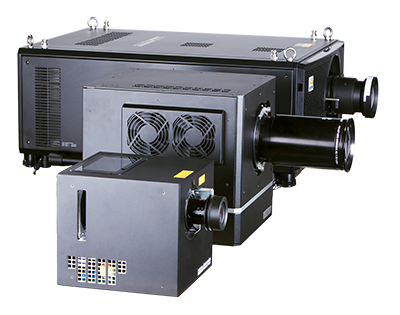 5. Digital Projection brought a preview of projectors based on its Satellite Modular Laser System (MLS) to ISE 2020. Satellite MLS offers a small number of simple building blocks that will allow users to address a wide range of applications, from single projector installs to complex, multi-channel domes, caves and simulators. One goal of the system is to make high-end imaging accessible to the wider AV market, at a cost-effective price point. The Satellite MLS will be developed around WUXGA, Native 4K and 8K resolutions and will also incorporate Digital Projection’s MultiView technology. The keystone of this new system is the separation of the light source, with its associated power and thermal management, to a remote location, which enables a small, compact projection head that only contains the minimal optical and video processing. By separating the projection head from the light source and linking the two by robust and flexible fibre-optic cables up to 100m long, Digital Projection’s latest innovation offers the installer many more options, particularly where space and access are restricted. Given the modular design of the system, there can be a one-to-many, or many-to-one relationship between the light sources and the projection heads.
5. Digital Projection brought a preview of projectors based on its Satellite Modular Laser System (MLS) to ISE 2020. Satellite MLS offers a small number of simple building blocks that will allow users to address a wide range of applications, from single projector installs to complex, multi-channel domes, caves and simulators. One goal of the system is to make high-end imaging accessible to the wider AV market, at a cost-effective price point. The Satellite MLS will be developed around WUXGA, Native 4K and 8K resolutions and will also incorporate Digital Projection’s MultiView technology. The keystone of this new system is the separation of the light source, with its associated power and thermal management, to a remote location, which enables a small, compact projection head that only contains the minimal optical and video processing. By separating the projection head from the light source and linking the two by robust and flexible fibre-optic cables up to 100m long, Digital Projection’s latest innovation offers the installer many more options, particularly where space and access are restricted. Given the modular design of the system, there can be a one-to-many, or many-to-one relationship between the light sources and the projection heads.
Digital Projection also continues to gain attention for INSIGHT 4K HFR 360 MultiView 3D projector with awards at ISE 2020. Enabled by ultra-fast frame rates and high resolution, this multi-view solution allows multiple viewers to have a unique viewing experience relative to their changing positions—from a single projector. Aside from visualization applications and virtual rides in theme parks, this technology applies to museums, with the ability to enable a virtual tour or interactive with an artifact with a personalized, high-resolution view for each user.
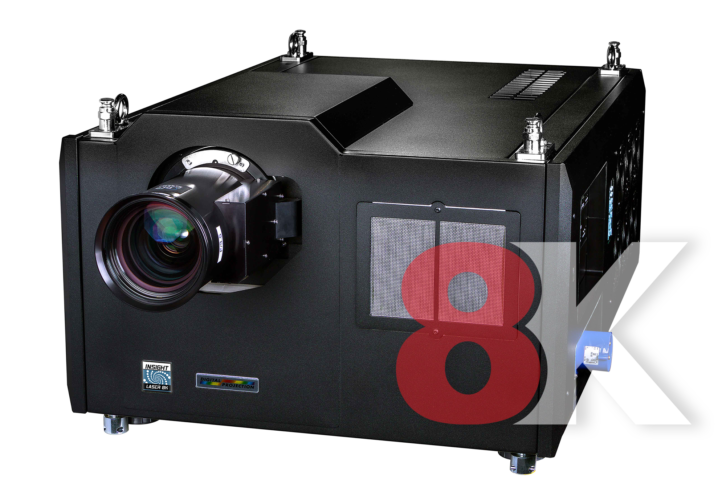
Digital Projection also brought it’s 8K DLP laser projector to ISE 2020, the INSIGHT LASER 8K, a world’s first when it originally debuted in 2018. Developed in collaboration with Delta Electronics, it provides an ultrahigh 8K resolution (7680 X 4320) of 33-million pixels with 36,000 lumens of solid-state laser-phosphor illumination—obviously pegged at resolution-critical, immersive visualization and large-venue applications. The INSIGHT LASER 8K utilizes DLP technology incorporating 3x 1.38” DarkChip DMD chips. On the software side, it carries DP’s proprietary Smear Reduction Technology, as well as the companies ColorMax technology to ensure color accuracy and black levels. These technologies produce accurate imaging characteristics, suited for matching projectors in tiled or blended applications. A capable selection of zoom lenses, providing extensive lens shift, ensures integrators installing the INSIGHT LASER 8K will have complete flexibility with respect to projector placement in both portrait and landscape. A companion controller software is ideal for use in large installations or where projectors are in multiple locations in a building; the software can dramatically reduce the time required for setup and configuration from a single network-enabled PC.
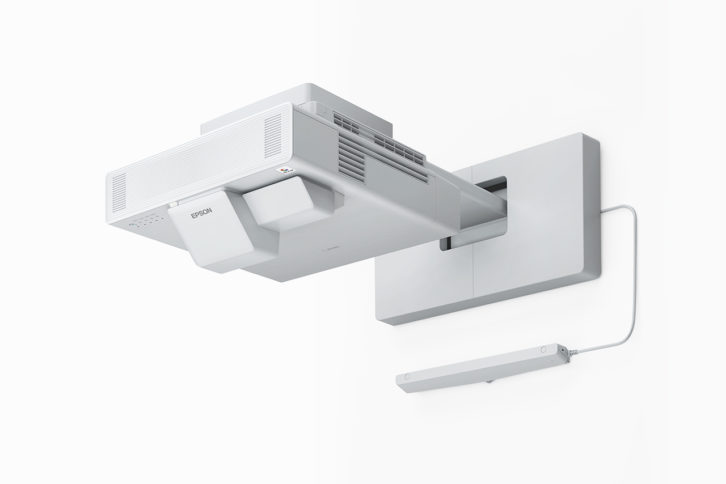 6. Epson showcased a range of products at ISE 2020 including the laser-powered BrightLink 1485Fi interactive display, the high-end 30,000-lumen L30000U, and an all-new ELPLX03 ultra short-throw lens for Epson’s 30K and 25K high lumen projectors. Epson also used their booth to emphasize the broadening projector 2020 ecosystem. The company brought a projection mapping experience called “EpsonUnbox” incorporating eight distinct and complex scenes with graphics and projection mapping effects. Epson also demonstrated Moverio augmented reality (AR) smart glasses in association with Emozionella and Toledo Train Vision and in combination with Epson’s high lumen projectors. A unique heads-up, hands-free high-resolution SiOLED display, it supports options for the arts, entertainment and tourism industries.
6. Epson showcased a range of products at ISE 2020 including the laser-powered BrightLink 1485Fi interactive display, the high-end 30,000-lumen L30000U, and an all-new ELPLX03 ultra short-throw lens for Epson’s 30K and 25K high lumen projectors. Epson also used their booth to emphasize the broadening projector 2020 ecosystem. The company brought a projection mapping experience called “EpsonUnbox” incorporating eight distinct and complex scenes with graphics and projection mapping effects. Epson also demonstrated Moverio augmented reality (AR) smart glasses in association with Emozionella and Toledo Train Vision and in combination with Epson’s high lumen projectors. A unique heads-up, hands-free high-resolution SiOLED display, it supports options for the arts, entertainment and tourism industries.
Also, in January, Epson debuted seven new PowerLite projector for 2020 built specifically for the K-12 education environment to increase student engagement and collaboration. The PowerLite E20, X49 and W49 are powerful, budget-friendly classroom projectors; the PowerLite 118, 119W, 982W, and 992F are networkable classroom projectors with premium connectivity and audio. The PowerLite 992F also comes equipped with Miracast and built-in wireless with enterprise-level security for enhanced connectivity. They also allow educators to simultaneously display content from up to four devices with the Epson iProjection wireless display solution with a builtin moderator function. Plus, with Miracast technology, the PowerLite 992F allows educators to easily connect with a laptop, tablet or smartphone and mirror Full HD content including movies, videos, photos and music – all without a single cable.
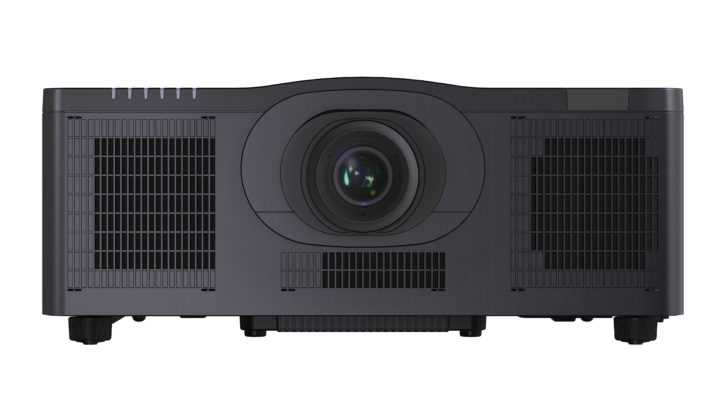 7. In October last year, Maxell Pro AV completed the transition to take over the Hitachi projector line. Shortly before that Maxell announced an expansion to its Professional Projector line with the MP-WU8701 (7000lm) and MP-WU8801 (8000lm) 3LCD laser projectors. Laser projectors from Maxell offer 20,000 hours of maintenance-free operation, and when Long Life 2 Mode is used projectors can get up to 50,000 hours of operation. Interchangeable lens functionality ensures the projectors fit the need of every type of installation. Maxell’s MP-WU8701 and MP-WU8801 feature blending and warping capabilities via manual adjustment or by using Maxell’s Projector Blending Tool 3 which utilizes a camera and software to automatically make adjustments. The series enables 4K signal input on HDMI1, HDBaseT and Display Port input terminals. Both models feature WUXGA 1920 x 1200 resolution with a 2,500,000:1 contrast ratio. Additionally, secure embedded networking gives customers the ability to manage and control multiple projectors from one centralized location to schedule events, transfer images, create email alerts, as well as to receive centralized reporting and conduct routine maintenance.
7. In October last year, Maxell Pro AV completed the transition to take over the Hitachi projector line. Shortly before that Maxell announced an expansion to its Professional Projector line with the MP-WU8701 (7000lm) and MP-WU8801 (8000lm) 3LCD laser projectors. Laser projectors from Maxell offer 20,000 hours of maintenance-free operation, and when Long Life 2 Mode is used projectors can get up to 50,000 hours of operation. Interchangeable lens functionality ensures the projectors fit the need of every type of installation. Maxell’s MP-WU8701 and MP-WU8801 feature blending and warping capabilities via manual adjustment or by using Maxell’s Projector Blending Tool 3 which utilizes a camera and software to automatically make adjustments. The series enables 4K signal input on HDMI1, HDBaseT and Display Port input terminals. Both models feature WUXGA 1920 x 1200 resolution with a 2,500,000:1 contrast ratio. Additionally, secure embedded networking gives customers the ability to manage and control multiple projectors from one centralized location to schedule events, transfer images, create email alerts, as well as to receive centralized reporting and conduct routine maintenance. 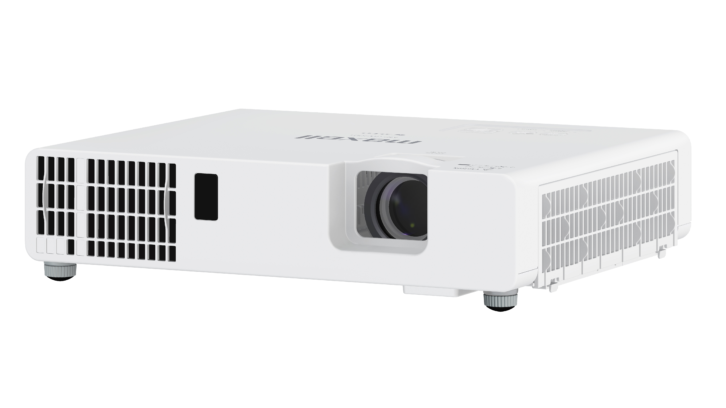 As we go to press, Maxell announced the expansion of its laser projector lineup with the compact, lightweight, budget 3LCD J Series projectors for class and conference room environments. The MP-JW4001 (4000lm/ WXGA), MP-JU4001 (4000lm/WUXGA) and MP-JW3501 (3500lm/WXGA) laser projectors utliize a new phosphor chip technology, which replaced the phosphor wheel and motor, results in fewer moving parts for better reliability and quieter operation. All are wireless presentation compatible.
As we go to press, Maxell announced the expansion of its laser projector lineup with the compact, lightweight, budget 3LCD J Series projectors for class and conference room environments. The MP-JW4001 (4000lm/ WXGA), MP-JU4001 (4000lm/WUXGA) and MP-JW3501 (3500lm/WXGA) laser projectors utliize a new phosphor chip technology, which replaced the phosphor wheel and motor, results in fewer moving parts for better reliability and quieter operation. All are wireless presentation compatible.
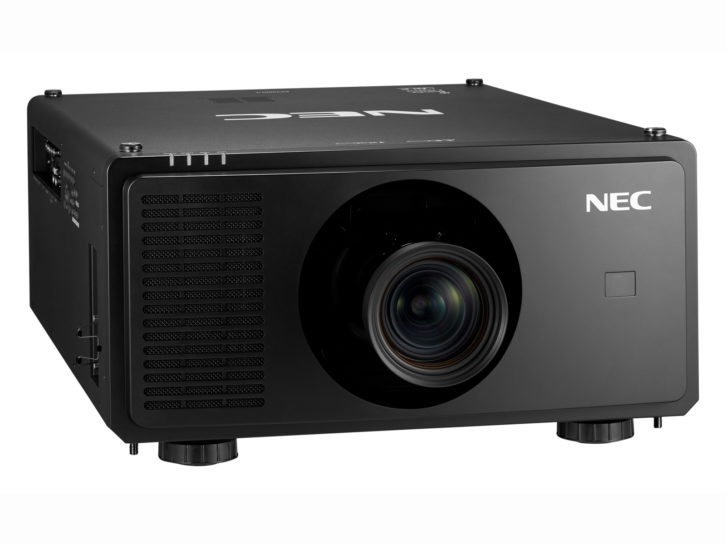 8. At the end of February, NEC Display introduced the NP-PX2000UL high-brightness (20,000lm) single-chip DLP projector with RB laser; it’s WUXGA (1920×200). It’s pitched at higher education, corporate, museum, theater, house of worship and digital signage applications. NEC believes that the RB laser (red assist) light source can bring a single-chip DLP to near 3-chip quality, but obviously at a fraction of the cost. No word on whether it eliminates the singlechip rainbow effect. The sealed optical engine is important for maintenance cost and downtime. NEC is also positioning it beyond traditional large-format applications in the house of worship, staging, and museum verticals, whether that’s edge-blending, projection-mapping or collaboration. Geometric correction supports a wide range of angles and projection surfaces. Available now.
8. At the end of February, NEC Display introduced the NP-PX2000UL high-brightness (20,000lm) single-chip DLP projector with RB laser; it’s WUXGA (1920×200). It’s pitched at higher education, corporate, museum, theater, house of worship and digital signage applications. NEC believes that the RB laser (red assist) light source can bring a single-chip DLP to near 3-chip quality, but obviously at a fraction of the cost. No word on whether it eliminates the singlechip rainbow effect. The sealed optical engine is important for maintenance cost and downtime. NEC is also positioning it beyond traditional large-format applications in the house of worship, staging, and museum verticals, whether that’s edge-blending, projection-mapping or collaboration. Geometric correction supports a wide range of angles and projection surfaces. Available now.
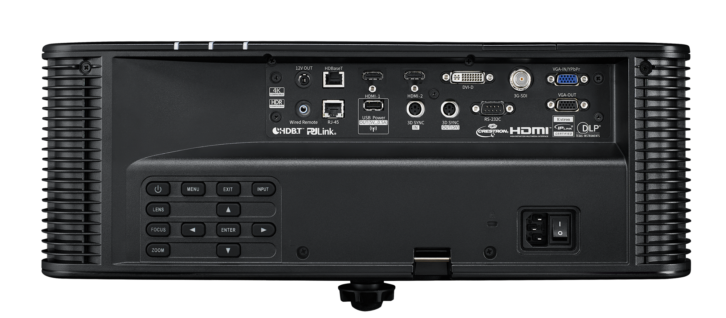 9. As we go to press, Optoma is on a bit of a tear with entertainment laser projectors. The headline-grabbing UHD50X is a home theater projector, but as “the world’s first 240Hz 4K-ready projector” it deserved a mention for its high refresh rate aimed at gaming and entertainment. Previously this year, Optoma had also unveiled three new laser projectors designed for gaming. The GT1090HDR and HZ39HDR, Optoma’s first laser gaming and entertainment projectors, are native 1080p with options in 4000 and 4200 lumens. The 3600 lumen HD28HDR supports up to a 120Hz refresh rate and an 8.4ms response time for fast-paced gaming, as well as an integrated game display mode that boosts shadows and dark scenes for greater visibility of impending obstacles. On the Pro AV side, in January, Optoma unveiled the ZU860 – an 8500 lumen, WUXGA, 4K UHD HDR projector with edge-blending, image warping, interchangeable lenses and IO including HDMI, DVI-D, HDBaseT, and 3G-SI. LAN and RS232 enable control via Crestron, Extron, AMX or Telnet. It’s Optoma’s first WUXGA interchanageable lens projector to support 4K inputs. Integrated image warping, blending, four-corner adjustment and lens position memory simplify complex installations. A variety of premium lens options, motorized lens-shift, zoom and focus with 360° and portrait operation ensure installation flexibility.
9. As we go to press, Optoma is on a bit of a tear with entertainment laser projectors. The headline-grabbing UHD50X is a home theater projector, but as “the world’s first 240Hz 4K-ready projector” it deserved a mention for its high refresh rate aimed at gaming and entertainment. Previously this year, Optoma had also unveiled three new laser projectors designed for gaming. The GT1090HDR and HZ39HDR, Optoma’s first laser gaming and entertainment projectors, are native 1080p with options in 4000 and 4200 lumens. The 3600 lumen HD28HDR supports up to a 120Hz refresh rate and an 8.4ms response time for fast-paced gaming, as well as an integrated game display mode that boosts shadows and dark scenes for greater visibility of impending obstacles. On the Pro AV side, in January, Optoma unveiled the ZU860 – an 8500 lumen, WUXGA, 4K UHD HDR projector with edge-blending, image warping, interchangeable lenses and IO including HDMI, DVI-D, HDBaseT, and 3G-SI. LAN and RS232 enable control via Crestron, Extron, AMX or Telnet. It’s Optoma’s first WUXGA interchanageable lens projector to support 4K inputs. Integrated image warping, blending, four-corner adjustment and lens position memory simplify complex installations. A variety of premium lens options, motorized lens-shift, zoom and focus with 360° and portrait operation ensure installation flexibility.
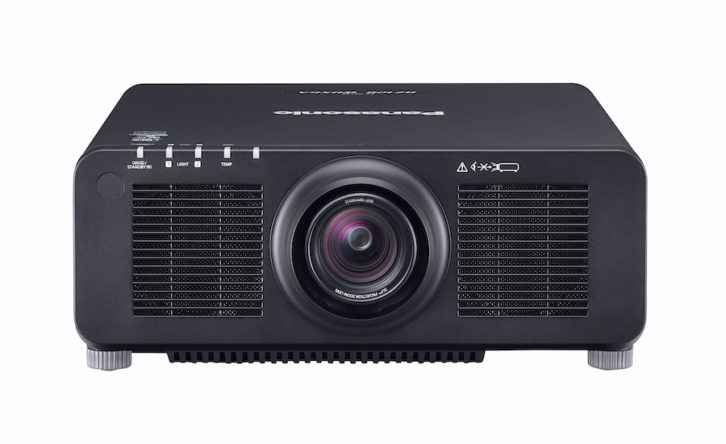 10. Panasonic is expanding its 1-Chip DLP laser projector 2020 line-up with the PT-RZ790 Series for museums and exhibition spaces and the PT-FRZ60 Series for high school and university classrooms in September. A clear, bright display in a well-lit classroom and minimal noise are essential for an ideal education environment. Similarly, exhibition designers use natural or tailored lighting to enhance their displays, and require quiet projection to welcome visitors into a calming atmosphere. The Panasonic PT-RZ790 Series and PTFRZ60 Series 1-Chip DLP laser projectors are engineered for these environments, serving high-visibility images under lights with almost no noise. At ISE, Panasonic also showcased its upcoming 3-chip DLP laser projector line-up. The SOLID SHINE projectors are 30,000K and up to 4K resolution. The PTRQ35K (4K) and PT-RZ34K (WUXGA) have light, compact designs (up to 60% the size of the current comparable projector); they are suitable for live events in stadiums and theatres, as well as a range of projection mapping applications. This new product also includes improved cooling systems. Dynamic Digital Control counters red-laser sensitivity to temperature by digitally regulating light output and operating parameters of a dedicated cooling system.
10. Panasonic is expanding its 1-Chip DLP laser projector 2020 line-up with the PT-RZ790 Series for museums and exhibition spaces and the PT-FRZ60 Series for high school and university classrooms in September. A clear, bright display in a well-lit classroom and minimal noise are essential for an ideal education environment. Similarly, exhibition designers use natural or tailored lighting to enhance their displays, and require quiet projection to welcome visitors into a calming atmosphere. The Panasonic PT-RZ790 Series and PTFRZ60 Series 1-Chip DLP laser projectors are engineered for these environments, serving high-visibility images under lights with almost no noise. At ISE, Panasonic also showcased its upcoming 3-chip DLP laser projector line-up. The SOLID SHINE projectors are 30,000K and up to 4K resolution. The PTRQ35K (4K) and PT-RZ34K (WUXGA) have light, compact designs (up to 60% the size of the current comparable projector); they are suitable for live events in stadiums and theatres, as well as a range of projection mapping applications. This new product also includes improved cooling systems. Dynamic Digital Control counters red-laser sensitivity to temperature by digitally regulating light output and operating parameters of a dedicated cooling system.
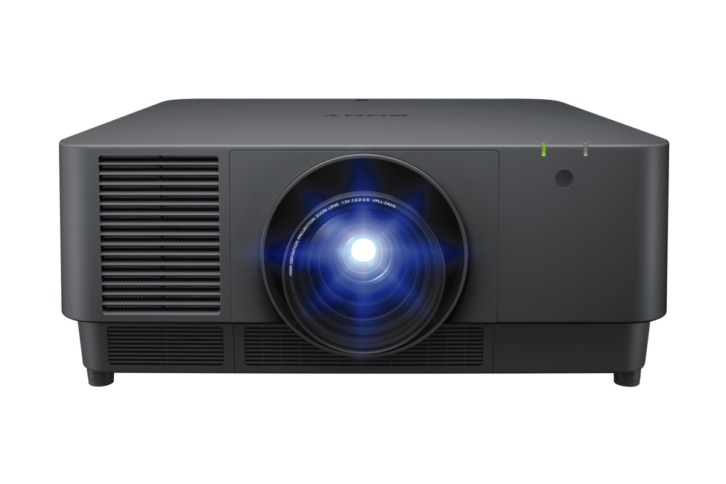 11. At ISE 2020, Sony expanded its laser projector 2020 line up with the introduction of six new models, ranging from a 13,000lm high brightness model to 5,000lm mid-range compact models. The high brightness offerings are strengthened with three new WUXGA models: VPL-FHZ131L (13,000lm), VPL-FHZ101L (10,000lm), and VPL-FHZ91L (9,000lm). In addition, the 5,000lm medium brightness models will now include the VPL-PHZ12 (WUXGA), which has a 0.76-inch LCD panel with an incorporated optical compensator to deliver bright images with high contrast of ∞:1 and true-to-life color reproduction. The new VPL-CWZ10 (WXGA) is a portable and compact entry model, which Sony claims as the most compact in the industry. Sony’s laser projector lineup comprises 11 models across different brightness levels from 4,200 to 13,000lm, providing options for a wide range of applications from small classrooms, conference venues to large halls and auditoriums and exhibition facilities, such as museums. All models share the Intelligent Setting function for set up, automatically adjusting the image quality, light source output level, and cooling system for the usage environment. Users can easily change the settings from a choice of preset mode, including: Meeting/Classroom Mode, which emphasizes the visibility of text in bright environments; Museum Mode, which prioritizes low-noise; and Facility Mode for entertainment venues, which reproduces impactful image quality with high contrast. In addition, VPL-FHZ131L, VPL-FHZ101L, and VPL-FHZ91L are equipped with an Advanced Intelligent Setting function with additional Multi-screen Mode, which optimizes color when projecting on multiple units. The new high-brightness WUXGA models combine a wide lens shift function with a short-focus lens. Its wide lens shift capability (Max. Vertical ±107%, Horizontal ±60%) enhances usability in a range of settings including difficult installation conditions, such as when a venue contains beams or piping, or when the screen is lower than the projector. When combined with the optional short-throw lens, the VPLL-Z4107, installation flexibility is enhanced in venues where throw distance is limited. 3G-SDI input is enabled with a separately sold adaptor. This makes it possible to operate projectors in city halls, event spaces, and other locations where projectors are often used together with broadcast equipment. In addition, the latest projectors now support the XTP Systems of Extron Electronics, in addition to Crestron Connected, for simple integration and operation. For the VPL-PHZ12, the major features are a 0.76-inch LCD panel with its incorporated optical compensator to deliver vibrant images with high contrast of ∞:1 and accurate color reproduction. Images and text can be seen clearly, even in bright environments. The VPL-CWZ10 adpots a small 0.64-inch panel, which makes the projector approximately 40% smaller (WxHxD = 371 x 100 x 319.3 mm) and 35% lighter (approx. 5.7 kg) than conventional models (VPL-PWZ10). The projectors will roll out over the coming months between April and June of this year.
11. At ISE 2020, Sony expanded its laser projector 2020 line up with the introduction of six new models, ranging from a 13,000lm high brightness model to 5,000lm mid-range compact models. The high brightness offerings are strengthened with three new WUXGA models: VPL-FHZ131L (13,000lm), VPL-FHZ101L (10,000lm), and VPL-FHZ91L (9,000lm). In addition, the 5,000lm medium brightness models will now include the VPL-PHZ12 (WUXGA), which has a 0.76-inch LCD panel with an incorporated optical compensator to deliver bright images with high contrast of ∞:1 and true-to-life color reproduction. The new VPL-CWZ10 (WXGA) is a portable and compact entry model, which Sony claims as the most compact in the industry. Sony’s laser projector lineup comprises 11 models across different brightness levels from 4,200 to 13,000lm, providing options for a wide range of applications from small classrooms, conference venues to large halls and auditoriums and exhibition facilities, such as museums. All models share the Intelligent Setting function for set up, automatically adjusting the image quality, light source output level, and cooling system for the usage environment. Users can easily change the settings from a choice of preset mode, including: Meeting/Classroom Mode, which emphasizes the visibility of text in bright environments; Museum Mode, which prioritizes low-noise; and Facility Mode for entertainment venues, which reproduces impactful image quality with high contrast. In addition, VPL-FHZ131L, VPL-FHZ101L, and VPL-FHZ91L are equipped with an Advanced Intelligent Setting function with additional Multi-screen Mode, which optimizes color when projecting on multiple units. The new high-brightness WUXGA models combine a wide lens shift function with a short-focus lens. Its wide lens shift capability (Max. Vertical ±107%, Horizontal ±60%) enhances usability in a range of settings including difficult installation conditions, such as when a venue contains beams or piping, or when the screen is lower than the projector. When combined with the optional short-throw lens, the VPLL-Z4107, installation flexibility is enhanced in venues where throw distance is limited. 3G-SDI input is enabled with a separately sold adaptor. This makes it possible to operate projectors in city halls, event spaces, and other locations where projectors are often used together with broadcast equipment. In addition, the latest projectors now support the XTP Systems of Extron Electronics, in addition to Crestron Connected, for simple integration and operation. For the VPL-PHZ12, the major features are a 0.76-inch LCD panel with its incorporated optical compensator to deliver vibrant images with high contrast of ∞:1 and accurate color reproduction. Images and text can be seen clearly, even in bright environments. The VPL-CWZ10 adpots a small 0.64-inch panel, which makes the projector approximately 40% smaller (WxHxD = 371 x 100 x 319.3 mm) and 35% lighter (approx. 5.7 kg) than conventional models (VPL-PWZ10). The projectors will roll out over the coming months between April and June of this year.


